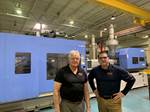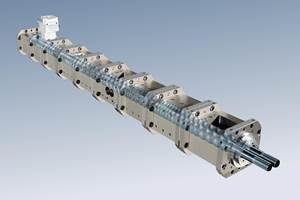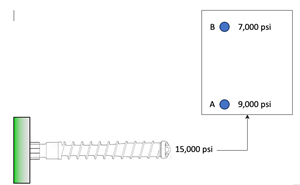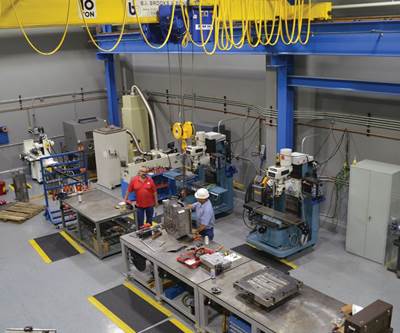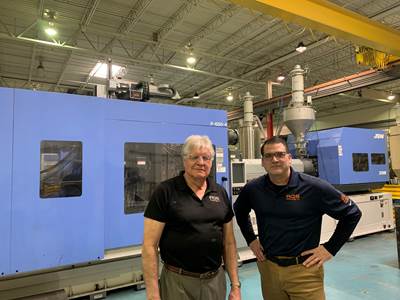Rethinking Regrind
Regrind and recycled material are often requisite in projects these days, but for many molders, the “R” word triggers painful memories.
I started in this industry back in 1994 at Cherry Electrical Products in its Control Device injection molding division as a third-shift machine operator. The title operator was stretching it a bit. Essentially, like many operators in this industry, I wasn’t much more than a packer and sorter. Soon after starting, I was given the opportunity to become a service worker, which was just Cherry’s way of saying material handler.
In that role, it was my job to make sure that material was dry and hoppers were full. All of Cherry’s products were allowed to run with a whopping 25% regrind; and since almost all of our molds were cold runners, regrind was something we were never short of. Now when I say 25% regrind, we aren’t talking about a gravimetric blender delivering nearly the exact specified amount of regrind to the loader, like we see today. We are talking about me mixing by hand what looked close to a quarter of a 5-gal bucket of regrind with virgin resin poured on top.

Regrind poses unique challenges to the molding process, but its use will only increase in coming years. (Photo: )
I’d shove my hands down into the bucket and mix it as best I could before dumping it in the machine or dryer hopper. Then I would take that same bucket and slide it under the dryer’s hopper and open the gate to allow it to fill with the newly dried mix of regrind and virgin. When I would go to the grinders and empty them, I would start to notice a powdering of the ground material.
The plastic would start looking less like a pellet and more like a colored powder. Now of course, we had no concept of generation control at this time—tracking the heat and process history of the plastics—all we knew was that every grinder needed to be emptied, and the regrind mixed into the virgin by the end of our shift. As we introduced more and more of this powdered material into the process, I would start to notice an increase in what we called “hot shots.”
This was when a mold flashed out due to degraded resin. It could take hours to clean out a hot shot and sometimes required the mold to get pulled and sent to the tool room. Keep in mind these were engineering-grade resins and not at all forgiving like a polyethylene or polypropylene. Hot shots were commonly blamed on a process technician not purging the machine sufficiently between cycle interruptions. This was true to a point, but I noticed over time that the length of time the machine was down before a mold would hot shot decreased when the amount of pulverized regrind was higher.
This is when I started throwing out the powdered material. When I was told I couldn’t do that, I decided that I just wouldn’t use it. We had used gaylords where we would put our excess regrind, so I would just toss any powdered regrind in those. This didn’t completely eliminate the flashing out of a mold with degraded material, but it reduced it significantly.
There is a big push to reduce as much waste as possible, but giving regrind a more interesting name doesn’t change many of the issues we had with it before the focus on recycling ramped up.
Within months of starting in this industry, I saw firsthand how much regrind could affect a molding process, and all of those impacts were negative to part quality, mold condition and process repeatability. We all probably have dozens of firsthand examples of what can go wrong when running regrind. I have found cell phones (in many many pieces), brass rods, hammers, a boot, all kinds of different beverage containers and more in grinders throughout the years.
On the medical side, not many jobs run regrind, but on the ones that do most of the foreign material is found by filtration and metal-detection systems. Outside of the medical industry, though, I haven’t seen many molders applying this type of filtration to their regrind. This is why most of the interesting things I’ve found in grinders were found while trying to troubleshoot an issue with part quality.
The “R” Word
Like it has for many of us in the industry, regrind became a bad word to me, and I would spend a lot of time proving the benefits of not running it from both a cost and quality prospective. I remember struggling to find a method to track the generations of regrind, but when using a mix like 25%, it is almost impossible to do. It just wasn’t worth the benefits from a cost perspective, but that was the wrong way of looking it. The environmental impact of disposing of all this resin should have been priority No. 1. Finding ways to run used materials and keeping them out of a landfill definitely should have been my motivation, but I, like many, was focused on the problem I could see.
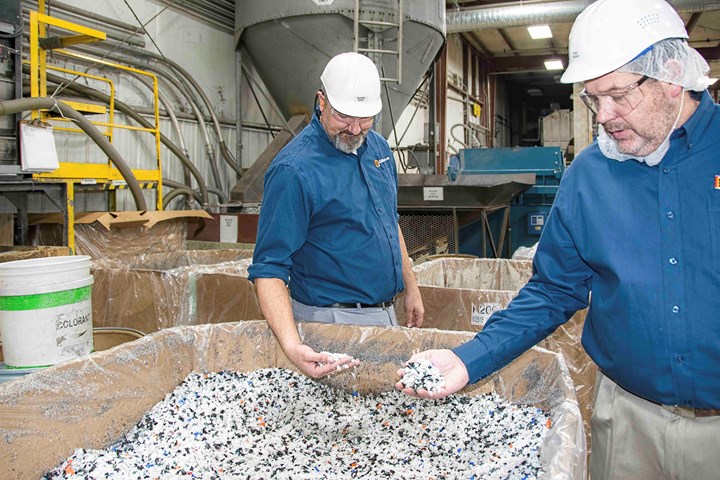
Post-consumer resin entails even more challenges than post-industrial resin. (Photo: PT)
Flash forward to 2021 and everyone now is trying to integrate some sort of recycled resins into their products. Customers who at one time clearly stated that regrind was not allowed in their products are now trying to use recycled resins in all of their lines. PCR (post-consumer recycle) and PIR (post-industrial recycle) have become major focuses of our industry.
Regrind would be classified as PIR, which usually—but not always—means it was recycled at the manufacturing facility. That differs from PCR, which is resin that is recycled after consumer use. There is a big push for all of us in this industry to do our part to reduce waste as much as possible, but giving regrind a more interesting name doesn’t change many of the issues we had with it before the recycling focus ramped up.
Within months of starting in this industry, I saw firsthand how much regrind could affect a molding process, and all of those impacts were negative to part quality, mold condition and process repeatability.
Just to be clear, regrind at the plant is just one type of PIR. Not all PIR is just ground-up scrap parts and runners. PIR also can be reprocessed regrind from multiple industrial sources. There are several recycling facilities that can take your scrap and turn it into near-virgin resin. This is same process that PCR goes through, where recycled plastics are reprocessed with additives through extruders and pelletized to provide a granulated resin that meets the specifications of the virgin resin. This is obviously a simplified, 30,000-ft view of this process, but the point is that this material is supposed to process identically to virgin material. Of course this will add cost to running regrind, but it should still be much less than virgin itself.
I recently spent time at a facility that does exactly what I describe above and was very impressed with the level of recycling that is taking place. The filtration systems there ensure that no foreign material (FM) is introduced into the system and can both separate metal from the grinding processes and separate FM from the extrusion process. This recycler was also using newspaper and fiberglass as fillers for some of their resins, which means that reprocessing used resin was not only preventing plastic from entering the landfill, it was also keeping these other materials out of them. I was very impressed with the entire reprocessing flow from start to finish. My only concern with repelletized materials—just as with any regrind—was being able to have some sort of generational control.
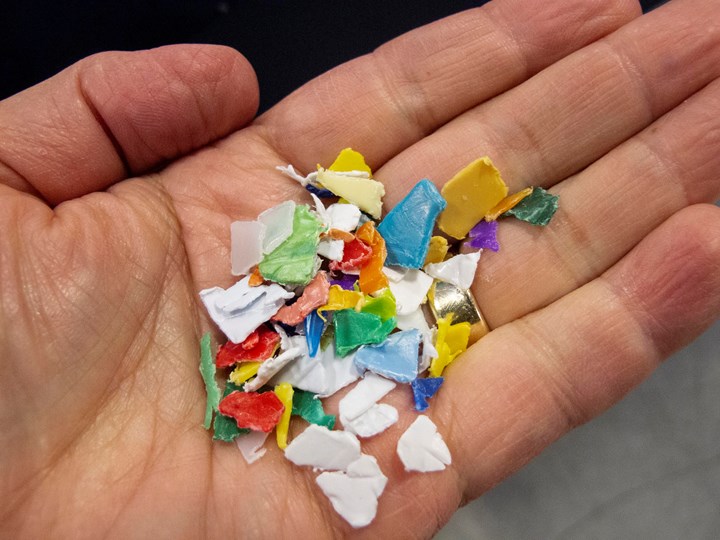
Molders should use virgin resin to establish process boundaries that can then be applied to scrap. (Photo: PT)
Tracking Generations
Each heat cycle that plastics experience, including compounding, is a degradation step. Each such step reduces the properties of a resin, and we lose some of the desired functionality of the material. I once wrote, “Our job as processors is to minimize degradation as much as possible,” and running regrind through an extruder to be returned to a pellet form does require an additional degradation step. On top of that, not knowing the generation of the regrind means that we don’t know how many times that resin has already been reground, and it is nearly impossible to track this effectively, even more so if a virgin-to-regrind-ratio used. So what can be done to ensure that repelletized resin with a critical amount of degradation isn’t being used to mold parts?
This got me thinking that the same could be said for PIR and PCR. How do I know that these materials either have material characteristics comparable to virgin in the case of PIR, or whether the PCR I’m running meets virgin-material specifications? These issues are going to be even more challenging then we faced years ago, with all the current pressure to reduce our environmental impact by using recycled resins.
I suppose if one had a fully equipped lab to test recycled materials, that would increase the likelihood that these materials would perform comparably to virgin. But you can’t test it all, of course, so even testing the material is not a guarantee that some contamination was not introduced. A lab can’t test 100% of the material, but the injection molding machine can.
Trust the Process
This first step is, as I’ve written before, is to develop a robust, repeatable process. This should be done with 100% virgin material. You cannot use the recycled resin for process development nor should you try to establish a separate process with the recycled resin if it is intended to replace the virgin material. If you have read any of my other columns, you know that I am a big proponent of developing tight process limits for all outputs once the process has been established—this is no different.
Just because the machine is capable of increasing or decreasing injection pressure based on the viscosity of the material, doesn’t mean it should be uncontrolled.
Allow your developed process to run a few different lots of virgin resin and record your outputs throughout the run to identify the machine’s normal variation when running the virgin material. Process limits should only be large enough to account for the normal variation, and they should be established for all the process outputs, including injection pressure. I have said many times that we need to stop thinking that our injection pressure is “supposed to vary.” It shouldn’t vary outside of the normal deviation we established. Just because the machine is capable of increasing or decreasing injection pressure based on the viscosity of the material, doesn’t mean it should be uncontrolled. When this happens, it means something has changed to cause it. Something in the overall process has caused the material’s viscosity to shift significantly, and we shouldn’t ignore it just because the machine can adjust for it.
If our recycled resin is running within the process limits we established, without any changes to the process, we can be confident that its characteristics are within the range of virgin material. If our injection pressure increases or decreases significantly, we know that our resin’s viscosity level has shifted, making it become easier or harder to fill. This doesn’t necessarily mean that our recycled resin is the issue, but with some quick troubleshooting we can eliminate the other causes and narrow it down to the material. At that point, this batch can be segregated from the others and testing can confirm our suspicions. If I have the ability to automatically divert a shot when it runs outside of the established process limits and to alarm after this happens a predetermined number of times, I can use my injection machine to ensure the recycled resin I am running is what we were expecting it to be.
It is important that all of us do what we can to reduce the impact of our industry on the environment, but we don’t have to sacrifice part quality to do so, as long as we are running a robust, repeatable process.
ABOUT THE AUTHOR: Robert Gattshall has more than 22 years’ experience in the injection molding industry and holds multiple certifications in Scientific Injection Molding and the tools of Lean Six Sigma. Gattshall has developed several “Best in Class” Poka Yoke systems with third-party production and process monitoring such as Intouch Monitoring Ltd. and RJG Inc. He has held multiple management and engineering positions throughout the industry in automotive, medical, electrical and packaging production. Gattshall is also a member of the Plastics Industry Association’s Public Policy Committee. In January 2018, he joined IPL Plastics as process engineering manager. Contact: (262) 909-5648; rgattshall@gmail.com.
Related Content
How to Configure Your Twin-Screw Barrel Layout
In twin-screw compounding, most engineers recognize the benefits of being able to configure screw elements. Here’s what you need to know about sequencing barrel sections.
Read MoreInjection Molding: Focus on these Seven Areas to Set a Preventive Maintenance Schedule
Performing fundamental maintenance inspections frequently assures press longevity and process stability. Here’s a checklist to help you stay on top of seven key systems.
Read MoreUnderstanding the Effect of Pressure Losses on Injection Molded Parts
The compressibility of plastics as a class of materials means the pressure punched into the machine control and the pressure the melt experiences at the end of fill within the mold will be very different. What does this difference mean for process consistency and part quality?
Read MoreHow Polymer Melts in Single-Screw Extruders
Understanding how polymer melts in a single-screw extruder could help you optimize your screw design to eliminate defect-causing solid polymer fragments.
Read MoreRead Next
Tool Maintenance: A Molder’s Must-Have
Equipping a toolroom for proper mold maintenance and repair takes more than just the right technology.
Read MoreRecycled Resin Gains Molder a Green Niche
Injection molder AGS Technology uses compounding know-how to turn old scrap into new auto parts that satisfy performance and sustainability goals.
Read MoreUnderstanding (and Using) Decompression to Your Advantage
Decompression—aka suckback—is a very important setting on an injection molding machine. On today’s machines, molders typically get the option to set decompression before and after screw rotation/recovery. Are they using this feature to their advantage?
Read More

